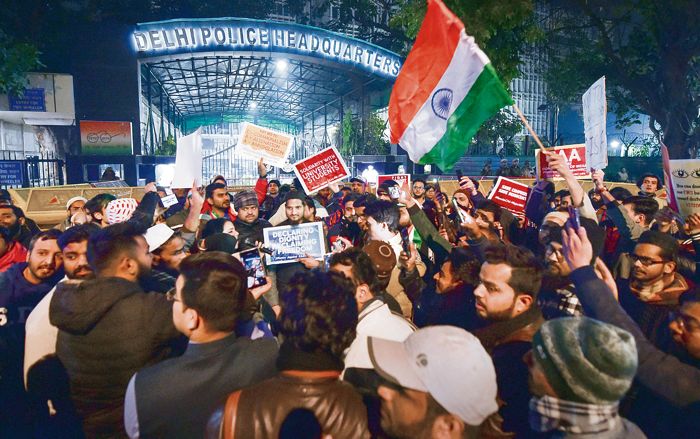
Suddenly, the Delhi Assembly polls have assumed a certain criticality in the current discourse on majoritarian politics, as if these elections hold the key to the final validation of the theory of the Hindu vote bank. The firing in the Jamia Millia Islamia neighbourhood at a peaceful protester by a right-wing agent provocateur, with the Delhi Police watching, has conclusively turned the Muslim unrest against the CAA and the fear of the NRC into the focal point of the poll campaign. The BJP’s final dash to the polling booth is fuelled solely by the politics of exclusivist Hindutva aimed at making the electorate choose the self-proclaimed protector of Hinduism.
Militant Hindutva is the only poll issue for the ruling party, which hopes to trigger a complete polarisation over the CAA-NRC debate. Even senior, sober leaders and ministers are participating in sloganeering that urges mobs to kill — ‘goli maaro saalon ko’ — while some others are reported to have demonised Muslims in poll speeches, claiming that Muslims would rape and kill Hindus. Those who script and articulate this sort of a campaign know only too well that every incident that occurs in Delhi gets amplified and reported across the country. The portrayal of Muslims and the rivals of BJP as traitors of the nation has only one blatant aim — to forge the Hindu vote bank.
It is indeed a low-stake experiment, as the BJP anyway was not expected to win the Delhi elections. But if it does win, it could be termed a referendum on all contentious policies unleashed by the government after returning to power in 2019 — an endorsement of the Hindutva agenda by a Hindu vote bank. Will it work?
Well, the ruling party at the Centre, with its immense resources and official and unofficial feedback dipsticks, believes that its campaign is succeeding. Otherwise, it would not have ventured to push the electorate into religious brackets. But if it succeeds, it would not be the spectacular success of Hindutva politics but the magnificent failure of inclusive politics, for the Delhi election has exposed the hollowness of the centrist formations in national politics.
The Congress is almost non-existent in the battle, without a chief ministerial candidate, an emotive or engaging campaign platform, or a determined organisational machinery, merely hoping that the Muslims would drift towards the party because of the stand taken by its leadership on the CAA-NRC issue. But the party made no attempt to forge a positive agenda to lure the Muslims (nearly 13% of Delhi’s population) or Scheduled Castes (17%), who together had formed the backbone of the Congress in the past and had the potential to launch it back into the reckoning. These polls are just a wasted opportunity for the Congress.
The AAP, on the other hand, was poised to win the elections comfortably with over 40 seats in the 70-seat Assembly before BJP launched its high-decibel war cry against ‘traitors’. The AAP had cleverly devised a strategy to underplay the CAA-NRC issue — to be not seen at Jamia or JNU or any other protest site or the AIIMS emergency ward, where the protesters with broken skulls were wheeled in.
CM Arvind Kejriwal’s act of seeking endorsement from the BJP and Congress voters was aimed at projecting a non-political, non-ideological, utilitarian platform. He talks only about his performance in delivering water, electricity, education and healthcare, primarily to the poor. Sure, he has made the supply of water and power cheaper and reliable. But the claims of better education and healthcare facilities ring hollow when Cabinet ministers and bureaucrats of Delhi do not opt for them and instead consider them an improved dole for the poorer sections.
The Delhi Government had a great opportunity to revolutionise the Capital’s education system by creating model schools that were good enough for the children of ministers, MLAs and bureaucrats. But Delhi’s tom-tommed schools remain the preserve of the poor with, of course, colourful furniture and highly-paid teachers. If these schools were so good, why did Kejriwal send his children elsewhere? This question pops up regularly on Internet discussion forums. Similar is the case with the mohalla clinics and the government healthcare system, which is a better and more responsive system for the working classes, but not good enough for the middle and upper middle classes.
A caste audit of the Kejriwal Cabinet also exposes the lack of real representation, beyond tokenism, for the SCs, Muslims and women. Even when he had to choose the Rajya Sabha nominees for his party, two of the chosen three were from his own community (and of indifferent antecedents). Its apathy towards strong ideological positions and its attempt to skirt the debate over majoritarian politics is a passive admission and endorsement of the Hindu vote bank, which is actually becoming a Hindutva vote bank.
The AAP, the supposedly idealistic and newest centrist formation, is ignoring the biggest debate of our times; it is cynically exploiting the inherent limitations of the first-past-the-post system in a multipolar contest. Since it is expected to defeat the BJP, it knows that all those opposed to the BJP will vote for it without the AAP having to engage with or counter Hindutva politics. The AAP has taken the minority votes for granted as a desperate inevitability and is bothered only about the Hindu voters getting swayed by hard Hindutva.
This is a dangerous moment in our democracy. First, thugs trooped out of JNU after their act of vandalism and violence, with streetlights switched off and the Delhi Police watching. The slogan then was ‘shoot the traitors’. Now a union minister is repeating one half of that slogan. A few days later, a juvenile pulls out a gun and shoots at a peaceful protester in daylight, again with the Delhi Police watching. Hope the Delhi poll outcome will cure this madness.
Join Whatsapp Channel of The Tribune for latest updates.




























